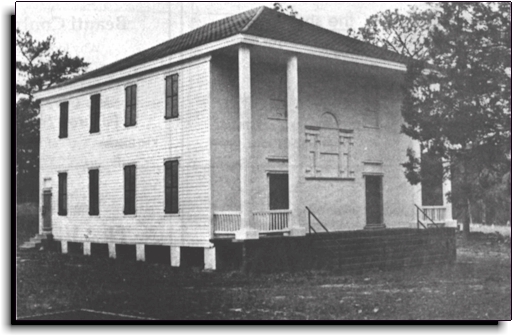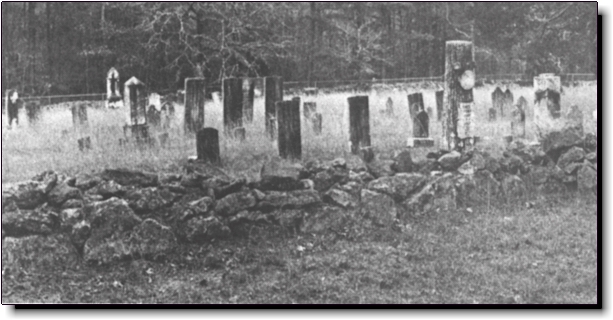MOORE
COUNTY NCGenWeb

This history of Long Street
Church
(believed to be written about 1930) is among the family papers of
Mrs. J. C. Robbins and Mrs.
Cecil Smith of Aberdeen.
| The history of the Long
Street
Church begins in the Highlands of Scotland, a stern and rugged land,
whose
harsh climate, and hard living conditions developed a strong and sturdy
race while the picturesque beauty of her heather-covered hills, deep
glens
and lovely lakes inspired noble thoughts and daring deeds.
Christianity came to the Highlanders in its early simplicity from Nanian at Whithorn and Colomba on the Isle of Iona. These people had a deep religious faith and adhered staunchly to it. In the isolation of the mountains, the clans grew and flourished with that intense loyalty to kith and kin, so marked the characteristic of the race. For centuries they struggled for freedom, often unsuccessfully. Such were the Highlanders from whom came the early settlers of the Cape Fear section of North Carolina. After the battle of Culloden in 1746, when George II gave "the rebellious Scots a chance to save themselves from the cruel sword of the Duke of Cumberland by a special oath of allegiance never to take up arms against the English Crown and by taking up residence in one of the English colonies," great numbers came to the Cape Fear section. Long Street seems to have been a favored spot. Here they found rolling hills covered with virgin forests of pine, long fertile valleys, well-watered good grazing, an abundance of game and the finest climate in the world. In 1756, the Yadkin Road, leading west from Cross Creek, over the Old Buffalo Trail was well established. This was the Long Street from which the church takes its name. Another road running north and south crossed the Yadkin River near the present site of the Long Street Church. West of the road leading north about 300 yards from the present location of the church was a log tavern and not far away stood a larger long building, the home of Alexander McKay. Here the Reverend Hugh McAden was entertained on the memorable occasion of his first visit. Let me Quote from "Old Bethesda" . . . "In June 1755, the Reverend Hugh McAden, the first Presbyterian Missionary set out on his long horseback ride from Pennsylvania over the ‘Great Wagon Road’ to North Carolina to examine the field to which the Presbytery assigned him. Six months later in January of 1756, he arrived at Long Street. Seeing a group of young Highlanders in hunting dress gathered near the tavern to quench their thirst after the day’s hunt, he stopped to ask his way and in so doing he saw close by, the house he sought, the home of Alexander McKay. Here he turned in and asked for a night’s lodging and a chance to preach to the Highlanders."
Mr. McAden says in the Journal: "Wednesday, January 28, 1756 - Rode up to Alexander McKay’s on the Yadkin Road, 30 miles; Thursday - preached to a small congregation, mostly Highlanders, who were very much obliged to me for coming and highly pleased with my discourse - though, alas, I am afraid it was all feigned and hypocritical." His reasons for thinking this was that some passed the night at the tavern nearby, drinking and using strong language. These people had no minister since coming to the colonies. This service in January 1756 marked the founding of the Long Street Church. Impressed by this spiritual destitution, Mr. McAden, who was not yet ordained, returned to Pennsylvania and persuaded his friend, Reverend James Campbell to come to the region of the Cape Fear River. Mr. Campbell was a native of Campbellton, Argus, Scotland. In 1730 he came to Pennsylvania where he was ordained and settled in the pastorate of the Scottish in that state. In 1757 he took up his residence west of the Cape Fear River opposite where the Bluff Church is now. Reverend Campbell preached first at his own house to great throngs who gathered to hear him and to enjoy the sound of Gaelic, their native tongue, from a man of culture and learning. Thus regular preaching points were soon established. Bluff called Roger’s Meeting House Barbecue called Clark’s Meeting House Long Street called McKay’s Meeting House
One year later, in 1758, Long Street, Bluff and Barbecue were organized into churches and elder ordained. At Long Street these were: Malcolm Smith, Archibald Ray and Archibald McKay (son of Alexander McKay). These three riders with those from Bluff and Barbecue issued a call to Mr. Campbell on October 18, 1758. John Patterson and two others were required to make bond for the payment of the minister’s salary, and for the good behavior of the congregation. Mr. Campbell served the churches without assistance until 1770 when Reverend James McLeod came over with some immigrants and joined Mr. Campbell in his ministry. They labored together with great success until 1776 when the smoldering fires of discontent and the growing desire for freedom burst forth into the American Revolution and the flocks scattered. Foote, in his "Sketches of North Carolina", calls Mr. McAden "the pioneer of the church in North Carolina". Mr. Campbell was the patriarch of Presbyterians in this state. "They that bring many to righteousness shall shine as the stars forever." Book of Daniel. For 167 years services were conducted on this spot until the entire Long Street area was taken over by the United States Government in 1919 to establish an Artillery School of Fire. This transfer brought into the treasury of the church a sum, of about five thousand ($5,000) dollars. This was used to endow "Long Street Ministerial Fund" at Davidson College. The fund was established in 1923. Note: Reverend R. A. McLeod was the last pastor of Long Street Church. The elders were Mr. N. D. M. Clark, Mr. J. D. Monroe and Mr. J. F. McFayden. In her long life of 167 active years the church had three houses of worship. The first, built in 1765 was of log and was destroyed by fire. The second, a commercial frame structure was located to the west of the present church near the corner of the cemetery. The present building, so well-cared for and preserved, was completed in 1847, while the Reverend Evander McNair was pastor. Interesting features are the unusual position of the pulpit and the outside entrance to the slave gallery. Land for the church and cemetery was given by Mr. Duncan McLaughlin and he is buried there.
Long Street, Bluff and Barbecue are the mother churches of the Presbytery, while Galatia, Cypress and Sandy Grove were set up by the members of Long Street. Long Street contributed also to the charter membership of McPherson, China Grove, Bethel, Bethesda, Union and Buffalo-Fayette Presbytery with more than 100 churches and 11,000 members, and Flora McDonald College as the fruit of their ministry. When Alexander Clarke arrived in the Cape Fear region with his band of immigrants in 1736, he found Hector McNeill of the Bluff, and John Smith already located. The latter is of special interest as the father of Malcolm Smith and Jane, later called Jenny the fair, in Gaelic, Jenny Bahn. She married Archibald McNeill of the Bluff and became famous far and wide "for her beauty, sprightliness and wit; and second in energy only to Flora McDonald." Malcolm Smith was the first elder of Long Street. Tradition, well-founded, says this Malcolm built and occupied what was rich in legends of long ago. Here Cornwallis spent the night. Here frightened little Effie Moore hid from the Tories. Scars left by their bayonets were still on the doors; the stage coaches passed nearby and stopped to change horses; the tavern was not far off where neighbors met to exchange gossip; for more than 100 years the latch string of the house hung hospitably outside. After the old home passed into the hands of the government a daughter of the house came back in 1927 to be married in Long Street Church, the only recorded wedding in its eventful history. Her brother, the Reverend Dougal McDougal, graduated from the seminary and is now preaching in West Virginia, the only son of Long Street Church to enter the ministry from there. Long Street has played her part in every war. How the Whigs and Tories fought at Piney Bottom is a matter of history. The fact that the Highlanders took different sides in the Revolutionary War is well-known and generally understood. Those who came early for industrial reasons and were well-established took the side of the Colonists - those who came later and those bound by their sacred oath abided by it were Tories. So it was with the first two pastors. Mr. Campbell championed the cause of the Colonists and prayed publicly for their success. This angered the Highlanders and to avoid trouble he withdrew to Guilford County, returning to the Bluff in 1780 and 1781. Mr. McLeod espoused the cause of England. As a result, he was taken prisoner and lodged in Halifax jail. Mr. Campbell appeared before the Provincial Congress and secured his release. At the beginning of the War Between the States, Major Mudock McLaughlin closed Long Street Academy and marched away with his students to enlist in Raleigh. Seven brothers of one John McKellar took another company. Reverend David Fairley of sainted memory was a chaplain in the Confederate Army.
In the neighborhood of Long Street the Battle of Monroe’s Crossroads was fought - a lively skirmish between Wheeler’s Cavalry and a detachment of Sherman’s men under Kilpatrick in 1865. In the World War when her other sons answered the country’s call, Reverend R. A. McLeod, the pastor of Long Street Church, served as a chaplain. Victor Blue, Surgeon General of the United States Army, and his brother, Rupert Blue, are descendants of the first Blue family who settled Long Street in 1748. All that remains of the Long Street School - once so important - is a sign. Here the Grahams and Rays, as well as many other taught. Near by the church is the Ranger’s house, Station No. 1, the boyhood home of Captain Neill W. Ray, built by his father over 100 years ago, and more recently occupied by the McFaydens. Just beyond the rock wall of the churchyard a marble shaft bears the inscription: "Confederate Soldiers", erected in 1870 by the women of the community to mark the graves of the unknown dead who fell in the Battle of Monroe’s Crossroads and in memory also of their own dead who had fallen elsewhere. The survivors of Captain John McKellar’s Company created a monument to their beloved commander in 1909. On the gentle slope of the hillside, Scotts from Islay, Jura and Argyle lie sleeping. The forefathers of Alexander Graham, a noted educator of Fayetteville and Charlotte are buried there. This unique family gave the following college presidents to North Carolina: Miss Mary Gwen Graham to Peace Institute, the late Dr. Edward Kidder Graham and Dr. Frank Porter Graham to the University of North Carolina.
Further west is an imposing monument to Reverend Angus McDiarmid, the third pastor of Long Street Church. Reverend McDiarmid is the only pastor of Long Street to be buried in the churchyard. Perhaps the old Scottish piper of whom Judge McRae writes so touchingly in his "Highland Scotch Settlement in North Carolina", found a last resting place here, for his weary old body when he heard sweeter music than his own beloved pipes, and slipped away to the far-off land of the blest. |
| Pastors of Long Street Church |
| Reverend James Campbell 1758-76 |
| Reverend John McLeod 1770-76 |
|
|
| Reverend Angus McDiarmid |
| Reverend Colin Lindsay |
| Reverend Colin McIvor |
| Reverend Evander McNair, dd |
| Reverend Neill McKay, dd |
| Reverend David Fairley, dd |
| Reverend Randall A. McLeod |
| The first six pastors of Long Street were natives of Scotland. During the ministry of the Reverend John McLeod, the second one to serve a pastor of Long Street, the communion cups were given. Reverend R. A. McLeod says in his history of Long Street, "Inseparably associated with the name of this zealous minister are two silver cups presented to him by some friends in Edinburgh for use in the communion services among the Highlanders in America.’’ |
| Sources:
Preface, Colonial Records of North Carolina, Vol. IV Carruthers History of North Carolina The Highland-Scotch Settlements of North Carolina - Judge James G. McRae Old Bethesda by Bion Butler Regimental History of North Carolina - Walter Clark History of Long Street - Reverend R. A. McLeod From an unpublished manuscript by Kate Broadfoot, Cumberland County Historian, Colonial Dames, July 1936
|
![]()

A view of the cemetery
located
behind Long Street Church.
Among those buried here are
some of the early families who attended this church
and 30 unknown Confederate
soldiers
who died at Monroe’s Cross Roads.
© 2009 to present - Sue Ashby & NCGenWeb Project
Updated -06/06/2022


